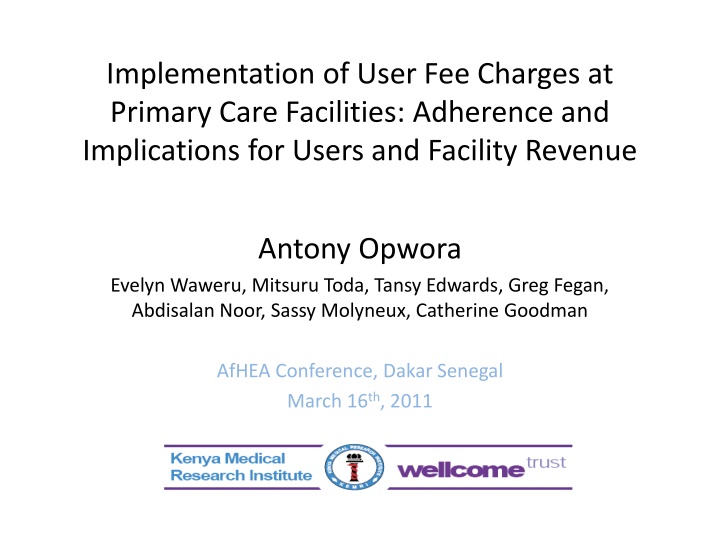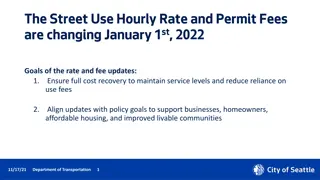
Adherence to User Fee Charges Policy at Primary Care Facilities
Explore the implementation and implications of user fee charges at primary care facilities in Kenya. The study focuses on the adherence to the user fee reduction policy, highlighting challenges and making recommendations for future policy implementation to ensure equitable access to healthcare.
Download Presentation

Please find below an Image/Link to download the presentation.
The content on the website is provided AS IS for your information and personal use only. It may not be sold, licensed, or shared on other websites without obtaining consent from the author. If you encounter any issues during the download, it is possible that the publisher has removed the file from their server.
You are allowed to download the files provided on this website for personal or commercial use, subject to the condition that they are used lawfully. All files are the property of their respective owners.
The content on the website is provided AS IS for your information and personal use only. It may not be sold, licensed, or shared on other websites without obtaining consent from the author.
E N D
Presentation Transcript
Implementation of User Fee Charges at Primary Care Facilities: Adherence and Implications for Users and Facility Revenue Antony Opwora Evelyn Waweru, Mitsuru Toda, Tansy Edwards, Greg Fegan, Abdisalan Noor, Sassy Molyneux, Catherine Goodman AfHEA Conference, Dakar Senegal March 16th, 2011
Background Universal access to health and MDGs: Reduce financial burden on patients for equity Major challenge for peripheral facilities: Accessing funds through the district health system PETS reports: 40% of resources do not reach them User fees is an alternative funding source that is widely adopted BUT..... user fees have documented negative impacts, especially for the poor Calls for their removal/reduction in developing countries
Background...2 User fee reduction policy (10/20 Policy) was adopted in Kenya in 2004 Concerns that implementation of the policy is far from perfect District level studies show that users continue paying high and variable fees for services Drug shortage, declining revenue, poor policy design and implementation processes National picture on adherence is warranted in view of planned direct funding to peripheral facilities Main objective Present a national picture on adherence to official user fee policy and make recommendations for implementation of future policy
Study Design Cluster randomized sample of facilities Randomly selected 24 districts Three non-municipal districts per Province (excl. Nairobi) and 3 municipal districts Randomly selected sample of facilities in each district, stratified by facility type Up to 7 health centres and 7 dispensaries in each district
Data Collection Fieldwork: July September 2010 Structured survey at each facility Interviews with facility in-charge (n=248) Records review of financial records (n=244) Exit interviews with 3 outpatients seeking curative care (n=698) Data entered directly onto mini-laptops
Data Analysis Analysis done using Stata TMv. 11 Used svy commands to account for: Variation in sampling probability Stratification by province and facility type Clustering at the district and facility level
Results 7
User Fee Policy Known locally as the 10/20 Policy All services at Dispensaries cost KES 10, and at Health Centres KES 20 Exemptions: All under five services ANC Special Conditions: Malaria, STIs + AIDS, TB Delivery Not clear: Registration/Card and Laboratory fees
Adherence to User Fee Policy (excl. patient card fees) Adult with TB 62.2% Child with pneumonia 53.7% Child with malaria 43.0% Mother requiring delivery 33.7% Woman at first ANC visit 22.3% Adult with pneumonia 15.8% Adult with gonorrhoea 4.3% Adult with malaria 4.2% All services 0.0% -10% 0% 10% 20% 30% 40% 50% 60% 70%
Adherence to User Fee Policy (excl. patient card and lab fees) Adult with TB 63.8% Child with malaria 55.9% Child with pneumonia 54.7% Mother requiring delivery 35.6% Woman at first ANC visit 31.2% Adult with pneumonia 26.9% Adult with malaria 6.4% Adult with gonorrhoea 5.7% All services 0.0% -10% 0% 10% 20% 30% 40% 50% 60% 70%
User Payments 74.7% had paid for services that day (median Kes.30) 5% owed the facility some money for treatment received Under 5 years old: median Kes.25 Over 5 years old: median Kes.20 24.9% needed to purchase additional medical supplies at a later stage, primarily drugs
Patient Card and Lab Fees Where patient card purchase was required, the median cost was 20 KES for all cases Lab fees varied: Delivery was median 350 KES and adults with TB was median 300 KES, though rarely charged More frequently charged were lab fees for first ANC visits (median 240 KES)
Facility Expenditure of All Revenue 82.0% of the facilities received income from user fees (Median income US$ 683; IQR 115 2,091) Mixed categories 3.8% Committee allowances 3.0% Electricity / water 3.9% Drugs 4.5% Wages 38.7% Stationary 6.4% Travel allowances 9.4% Non-drug supplies & equipment 20.8% Other 9.4%
Importance of User Fees Two thirds of support staff paid by user fees Volunteer 1.3% NGO 4.3% CDF 5.4% User fees 66.7% Government 22.4%
Discussion 15
Implementation of Direct Funding Direct funding through Health Sector Services Fund (HSSF) has been established by government of Kenya Funds credited directly to each facility s bank account starting in October 2010, after a successful pilot in Coast Fund managed by the facility committee (HFC) HSSF disbursed US$ 570 to each health centre to cover one quarter Equivalent to a year s median income for all facilities Significant if intended to replace user fees Current status of HSSF - Partial roll-out October 2010 in most health centres Planned for July 2011 a subset of dispensaries
Conclusion Operations of primary health facilities are hugely supported by user fees Adherence to official user fee policy is very low Users incur additional expenses beyond the user fees paid Direct funding may have the potential to ease the financial burden on users, only if adherence to user fees is greatly improved We recommend this could be enhanced by: Clarifying user fee guidelines Continued facility funding contingent on adherence Extra funding (e.g. performance based financing) for facilities strictly following the guidelines and those showing improved service quality
Acknowledgments Funding from DANIDA and MOPHS Technical assistance and advice from MOPHS staff Simon Mulwa and John Senga for database support Our very dedicated fieldwork team All interviewees for their time and warm welcome
Thank you 19






















